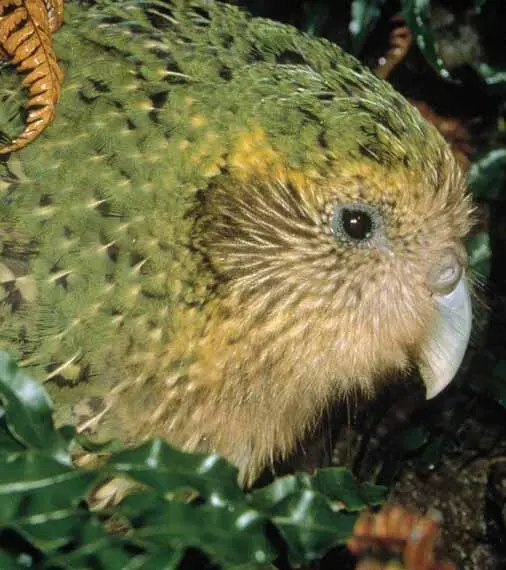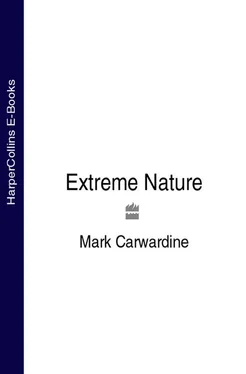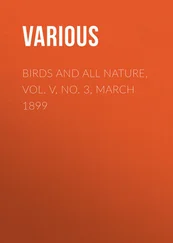When Basque whalers saw killer whales feeding on the carcasses of dead whales, they called them ‘whale killers’, and the name stuck. Many people prefer to use the more politically correct name, orca, but in Latin, orcus means ‘belonging to the kingdom of the dead’, and so it’s not much better.
| NAME |
African termite Macrotermes bellicosus |
| LOCATION |
sub-Saharan Africa |
| ABILITY |
creating an air-conditioned, multi-storey communal residence |
© John Shaw/NHPA
Some 200 species of ant – most famously leafcutter ants – farm fungus inside their nests as a source of fast food. So do about 3,500 beetles and 330 species of termite. But of all these insects, none seems to cultivate a more difficult crop than the African termite, and no crop requires more elaborate technology to maintain it. The staple fungus of African termites grows only on their faeces and needs a very particular temperature. Anything above or below 30.1°C (86°F) is too hot or too cold, and every aspect of the construction of the termite mound is part of an effort to keep the temperature exactly that.
The termites always build with mud, above a damp pit. They dig at least two long boreholes down to the water table. They also construct a 3m (10ft) diameter cellar, about 1m (3.3ft) deep, with a thick central pillar that supports the main part of the mound. This houses the queen, the nursery and the fungus farms. On the ceiling of the cellar are thin, circular condensation veins, and around the sides of the mound are ventilation ducts. On top are hollow towers – chimneys – that rise 6m (20ft) above ground level. Every dimension is just right for the precise circulation of air and moisture that will keep the fungus at 30.1°C no matter what it’s like outside. What’s more, workers are only a maximum of 2cm (0.8in) in size, and so in relative terms, the mound is taller than any human building – the equivalent of 180 storeys.
| NAME |
gympie-gympie stinging tree Dendrocnide moroides |
| LOCATION |
Australia |
| ABILITY |
defending itself with toxic chemicals |
© Bill Bachman/ANTphoto.com
Of course, any tree could fall on you, and plenty of trees are poisonous to eat, but this aside, the trees that cause the most excruciating pain are ones that you just brush against. These are the stinging trees that are found in several parts of the world but are most persistently painful in that land of advanced toxins, Australia. Here are six Dendrocnide species, two of which – the northern shiny-leaf stinging tree and the southern giant stinging tree – are large, tree-like trees, and four of which are more like shrubs. Of the six, the worst agony is said to be inflicted by a shrub, the gympie-gympie, but they all hurt a lot.
What looks at first like a layer of fur on all parts except the roots is really a mass of tiny glass (silicon) fibres containing toxic chemicals. Just a brush against a tree results in the skin being impaled with a scattering of fibres, which act like hypodermic needles and are all but impossible to extract (Australian first-aid kits sometimes include wax hair-removal strips). The poison causes burning, itching, swelling and sometimes blistering that is said to be at its most unbearable soon after contact but can keep causing pain for years. The fibres can penetrate most clothing, and sometimes air-borne ones can be inhaled. Oddly, the stings don’t affect all animals. Insects and even some native mammals actually eat the leaves. The ones that suffer tend to be introductions to Australia, such as dogs, horses and humans.
| NAME |
kakapo Strigops habroptilus |
| LOCATION |
New Zealand |
| ABILITY |
producing a boom that can be heard up to 5km (3 miles) away |

© ANT Photo Library/NHPA
Which bird is loudest depends on who is listening and where. The song of a nightingale overcoming traffic noise is so loud (90 decibels) that prolonged exposure to it could, theoretically, damage your ears. So could the even louder, shrill, 115-decibel cry of a male kiwi or the metallic ‘bonks’ of the Central American bellbird, designed to carry in thick rainforest. But possibly the best long-distance sound to make is a boom.
In Europe, the booming record-holder is the bittern. But the world record-holder is probably the New Zealand kakapo, which is now extinct on the two main islands and, despite great conservation efforts, numbers fewer than 90 individuals. Every three or four years, the normally solitary males gather at traditional kakapo amphitheatres – display grounds with excavated bowls. Here they puff up air sacs in their chest and belly and start booming, an average of 1,000 times an hour for 6–7 hours a night (kakapos are nocturnal, and sound carries best in the colder night air). They do this for 3–4 months to call in likely mates to witness their dance displays and for mating. But since this giant, flightless parrot is now confined to a handful of offshore islands, few people will ever hear its eerie, ‘fog-horn’ boom.
Intriguingly, the booms of Australasian cassowaries are nearly as loud but have an added long-distance element: a low-frequency component below the range of our hearing (though it can be felt). It’s likely that a kakapo boom also contains ultra-low-frequency sound, but its booming is now so rare that it has yet to be completely analysed.
| NAME |
Komodo dragon Varanus komodoensis |
| LOCATION |
islands of Komodo, Rinca, Gili Motang, Gili Dasami and Flores, Indonesia |
| ABILITY |
producing dangerous bacteria-laden saliva |
© Mark Carwardine
The Komodo dragon is a renowned giant: the average male is more than 2.2m (7ft 5in) long, and some measure up to 3.1m (10ft 2in). The longest lizard of all, however, is its much slimmer relative, the Salvadori monitor from New Guinea, though two thirds of its 2.7m (8ft 8in) maximum length is made up by its tail.
But the Komodo dragon is the heaviest lizard of all, with an average weight of 60kg (130lb) and a maximum of 80kg (176lb), and it is a fearsome predator. It has large, sharp, serrated teeth for cutting and tearing prey, but its hidden weapon is its bacteria-laden saliva. Once bitten, a victim may escape, but within a few days it will succumb to infection. The dragon then tracks it down with its acute sense of smell – a sense that also makes it a super-efficient scavenger.
Though it is a giant by today’s standards, the Komodo dragon may be a pygmy compared to one of its mainland ancestors (Flores Island supported other ‘pygmies’, including a now-extinct elephant, on which the dragon is believed to have preyed). In Australia there once existed a true giant, the 6.9m (23ft), 617kg (1,370lb) monster monitor Megalania prisca , which became extinct about 40,000 years ago. The Komodo dragon poses relatively little threat to humans and usually only bites when cornered. But Megalania , whether or not it was a deadly drooler, would have been a lizard to be very, very afraid of.
Читать дальше











![Various - Birds and Nature Vol. 11 No. 3 [March 1902]](/books/745532/various-birds-and-nature-vol-11-no-3-march-1902-thumb.webp)
![Various - Birds and Nature Vol. 9 No. 3 [March 1901]](/books/745788/various-birds-and-nature-vol-9-no-3-march-1901-thumb.webp)